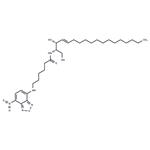Description
C6 NBD ceramide is a biologically active fluorescent analog of short chain, membrane-
permeable ceramides. It is as effective as C6 ceramide in the inhibition of viral glycoprotein transport through the Golgi. C6 NBD ceramide has been used as a fluorescent substrate for the activity of UDP-
glucose:ceramide glucosyltransferase and to demonstrate the translocation of glucocerebroside and sphingomyelin from the Golgi to the plasma membrane.
Chemical Properties
Rust or Dark Yellow Solid
Uses
A vital fluoresent stain for the Golgi apparatus.
Definition
ChEBI: N-{6-[(7-nitro-2,1,3-benzoxadiazol-4-yl)amino]hexanoyl}sphingosine is an N-acylsphingosine that is sphingosine with the amino nitrogen converted into a 6-{[N-(7-nitrobenzo-2,1,3-oxadiazol-4-yl)amino]}hexananamido group. It has a role as a fluorescent probe.
References
Chazotte (2012),?Labeling Golgi with Fluorescent Ceramides;?Cold Spring Harb. Protoc. (8):pdb.prot070599
van Meer et al. (1987),?Sorting of sphingolipids in epithelial (Madin-Darby canine kidney) cells; J. Cell Biol.?105 1623
Don and Rosen (2008),?A fluorescent plate reader assay for ceramide kinase; Anal. Biochem.?375 265
Nikolova-Karakashian (2021),?Methods to Characterize Synthesis and Degradation of Sphingomyelin at the Plasma Membrane and Its Impact on Lipid Raft Dynamics; Methods Mol. Biol.?2187 113



